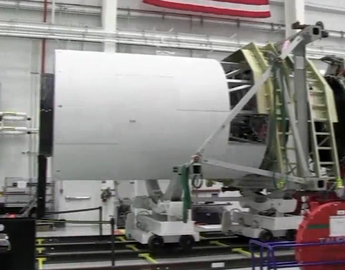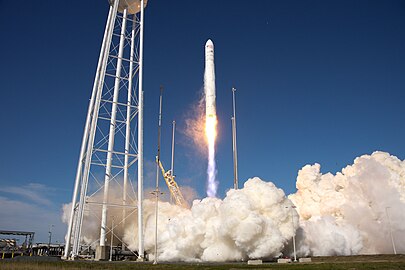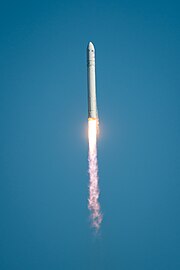Antares A-ONE
 The Antares 110 lifts off at the start of the mission | |
| Names | Simulated Cygnus Payload[1] |
|---|---|
| Mission type | Flight test |
| Operator | Orbital Sciences Corporation |
| COSPAR ID | 2013-016A |
| SATCAT no. | 39142 |
| Mission duration | 18 days, 3 hours, 57 minutes |
| Spacecraft properties | |
| Spacecraft | Cygnus mass simulator |
| Manufacturer | Orbital Sciences Corporation |
| Launch mass | 3,800 kg (8,400 lb) |
| Dimensions | 5.061 m × 2.896 m (16.60 ft × 9.50 ft) |
| Start of mission | |
| Launch date | 21 April 2013, 21:00:00 UTC (5:00 pm EDT)[2][3] |
| Rocket | Antares 110[4] |
| Launch site | MARS, Pad 0A |
| End of mission | |
| Disposal | Deorbited |
| Decay date | 10 May 2013, 00:57 UTC[5] |
| Orbital parameters | |
| Reference system | Geocentric orbit[6] |
| Regime | Low Earth orbit |
| Perigee altitude | 223 km (139 mi)[5] |
| Apogee altitude | 237 km (147 mi)[5] |
| Inclination | 51.63°[5] |
 Orbital Sciences insignia | |
Antares A-ONE mission was the maiden flight of Orbital Sciences Corporation' Antares launch vehicle including the ascent to space and accurate delivery of a simulated payload, the Cygnus Mass Simulator (CMS), which was launched 21 April 2013.[6] It was launched from Pad 0A at the Mid-Atlantic Regional Spaceport (MARS), Wallops Flight Facility, Virginia.[6] The simulated payload simulates the mass of the Cygnus cargo spacecraft.[6] This dummy payload was sent into an orbit of 223 km × 237 km (139 mi × 147 mi) with an orbital inclination of 51.63°, the same launch profile it will use for Orbital's Cygnus cargo supply missions to the International Space Station (ISS) for NASA.
This launch along with several other activities leading up to it, are paid milestones under NASA's Commercial Orbital Transportation Services (COTS) program.[7]
Primary payload
[edit]The primary payload was the Cygnus Mass Simulator. It had a height of 5.061 m (16.60 ft), a diameter of 2.896 m (9 ft 6.0 in) and a mass of 3,800 kg (8,400 lb).[8] It was equipped with 22 accelerometers, 2 microphones, 12 digital thermometers, 24 thermocouples and 12 strain gages.[8]
Secondary payloads
[edit]Four Spaceflight Industries Inc. CubeSat nanosatellites were deployed from the dummy payload.[9]
The secondary payloads were four CubeSats that were deployed from the CMS.[8] Three of them were PhoneSats, 1U CubeSats built by NASA's Ames Research Center.[8] These were named Alexander, Graham and Bell, after the Alexander Graham Bell, inventor of the telephone.[8] The purpose of these three satellites was to demonstrate the use of smartphones as avionics in CubeSats.[8] They each had a mass of 1,124 kg (2,478 lb) and were powered by lithium batteries.[8] The fourth nanosat was a 3U CubeSat, called Dove-1, built by Cosmogia Inc. It carried a "technology development Earth imagery experiment" using the Earth's magnetic field for attitude control.[8][10]
Mission timeline
[edit]- Lift off of the Antares launch vehicle occurs two seconds after the first stage engines are ignited
- The first stage engines shut off 228 seconds after lift-off
- At 233 seconds, the first stage separates from the second
- At 317 seconds, the payload fairing is jettisoned
- At 326 seconds, the second stage's engine is ignited
- At 481 seconds, the second stage is shut off
- At 601 seconds, the Cygnus Mass Simulator separates [6]
Launch attempt summary
[edit]Note: Times are local to the launch site (Eastern Daylight Time).
| Attempt | Planned | Result | Turnaround | Reason | Decision point | Weather go (%) | Notes |
|---|---|---|---|---|---|---|---|
| 1 | 17 Apr 2013, 5:00:00 pm | Scrubbed | — | Technical | 17 Apr 2013, 4:44 pm (T−12:00) | 60[11] | Premature disconnect of upper stage umbilical cable during T−12:00 hold.[12] |
| 2 | 20 Apr 2013, 6:10:00 pm | Scrubbed | 3 days 1 hour 10 minutes | Weather | 20 Apr 2013, 4:30 pm | 90 | [13] |
| 3 | 21 Apr 2013, 5:00:00 pm | Success | 0 days 22 hours 50 minutes | 80 | First flight of Antares.[14] |
Gallery
[edit]See also
[edit]References
[edit]- ^ "Display: Simulated Cygnus Payload 2013-016D". NASA. 27 April 2021. Retrieved 25 May 2021.
 This article incorporates text from this source, which is in the public domain.
This article incorporates text from this source, which is in the public domain.
- ^ "Antares A-ONE Mission Coverage". Spaceflight101. 21 April 2013. Archived from the original on 15 February 2016. Retrieved 6 January 2016.
- ^ Clark, Stephen (20 April 2013). "Antares A-One Mission Status Center". Spaceflight Now. Retrieved 20 April 2013.
- ^ Bergin, Chris (22 February 2012). "Space industry giants Orbital upbeat ahead of Antares debut". NASASpaceFlight.com. Retrieved 29 March 2012.
- ^ a b c d McDowell, Jonathan C. (5 August 2024). "General Catalog of Artificial Space Objects". planet4589.org. Retrieved 6 August 2024.
- ^ a b c d e "Orbital Sciences successfully launches first Antares rocket". Northrop Grumman. 21 April 2013. Retrieved 25 May 2021.
- ^ "Space Act Agreement Amendment Seven between NASA and Orbital Sciences Corporation for COTS" (PDF). NASA. 30 March 2011. Retrieved 25 May 2021.
 This article incorporates text from this source, which is in the public domain.
This article incorporates text from this source, which is in the public domain.
- ^ a b c d e f g h "Antares Test Launch "A-ONE Mission" Overview Briefing" (PDF). Orbital Sciences. 17 April 2013. Retrieved 18 April 2013.
- ^ Lindsey, Clark (21 March 2013). "Spaceflight Services installs four nanosats on Antares rocket". NewSpace Watch. Archived from the original on 20 May 2013. Retrieved 21 March 2013.
- ^ "Cosmogia Dove-1 Orbital Debris Assessment Report". FCC. 6 January 2012. Retrieved 25 May 2021.
 This article incorporates text from this source, which is in the public domain.
This article incorporates text from this source, which is in the public domain.
- ^ Orbital Sciences (17 April 2013). "Still marching toward the first launch..." Twitter.
- ^ Orbital Sciences (17 April 2013). "The umbilical was a data cable connected..." Twitter.
- ^ Orbital Sciences (20 April 2013). "#Antares launch attempt scrubbed..." Twitter.
- ^ Harwood, William (21 April 2013). "Antares rocket climbs into space on maiden flight". CBS News.
External links
[edit]- Antares Pre-Launch "A-ONE Mission" Briefing
- Antares A-One Mission Overview
- NASA WFF mission page
- Video of Pre-Flight Press Conference - Part 1 - YouTube (NASA TV)
- Video of Pre-Flight Press Conference - Part 2 - YouTube (NASA TV)
- Video of Antares A-One being rolled out to launch pad - YouTube (NASA TV)
- Video of the launch of the Antares A-One Mission - YouTube (NASA TV)





